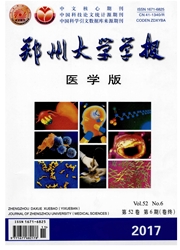

 中文摘要:
中文摘要:
目的:构建CYP3A4*1G依赖的CYP3A4内含子10启动的真核表达载体,研究CYP3A4*1G依赖的CYP3A4内含子10的启动子功能。方法:以质粒p GEM-CYP3A4为模板扩增出CYP3A4 c DNA,PCR产物经EcoRV、XbaⅠ双酶切后插入到pc DNA3.1/Hygro(+)的EcoRV、XbaⅠ双酶切位点之间,构建pc DNA3.1-3A4。分别以人基因组DNA和p GEM-CYP3A4质粒DNA为模板,扩增出CYP3A4启动子和CYP3A4内含子10全长(野生型和突变型)序列,插入到pc DNA3.1-3A4的MluⅠ、NheⅠ双酶切位点之间,取代原有的CMV启动子,构建pc DNA3.1-P3A4、pc DNA3.1-W3A4(野生型)和pc DNA3.1-M3A4(突变型)。将质粒转染入HepG2细胞,检测CYP3A4 mRNA表达水平。结果:构建的重组质粒经酶切验证与测序鉴定,插入片段的序列和方向与预期完全一致。与转染pc DNA3.1/Hygro(+)的HepG2细胞比较,pcDNA3.1-P3A4、pc DNA3.1-W3A4、pc DNA3.1-M3A4转染组细胞CYP3A4 mRNA表达水平均提高(P〈0.05),但pc DNA3.1-M3A4组表达水平低于pc DNA3.1-P3A4和pc DNA3.1-W3A4组(P〈0.05)。结论:成功构建了CYP3A4*1G依赖的CYP3A4内含子10启动的真核表达载体;CYP3A4内含子10能够启动CYP3A4基因的表达,且存在CYP3A4*1G等位基因依赖性。
 英文摘要:
英文摘要:
Aim:To construct CYP3A4 eukaryotic expression vector which promoted by CYP 3A4 intron 10 regulated by CYP3A4*1G.Methods:The segment of CYP3A4 cDNA was amplified from plasmid pGEM-CYP3A4 by PCR,and the PCR product was digested with EcoRV and XbaⅠ and ligated into pcDNA3.1/Hygro( +) to obtain vector pcDNA3.1-3A4.The segment of CYP3A4 promoter and that of the full-length of CYP3A4 intron 10 with CYP3A4*1G allele were am-plified from human genome DNA and pGEM-CYP3A4,respectively,then were ligated into pcDNA3.1-3A4 between the sites of restriction enzyme MluⅠand NheⅠreplacing the CMV promoter ,to obtain pcDNA-P3A4,pcDNA3.1-W3A4 and pcD-NA 3.1-M3A4.The vectors were transfected into HepG 2, respectively, and the levels of CYP3A4 mRNA were detected by quantitative real-time PCR.Results: These insertion sequences and their directions were exactly correct .The CYP3A4 mRNA level of CYP3A4promoter transfection group , intron 10 ( GG) group, intron 10 ( AA) transfection group were all higher compared with empty plasmid transfection group .The CYP3A4 mRNA level of intron 10 (AA ) group was lower than those of CYP3A4 promoter group and intron 10 (GG) group (P〈0.05).Conclus ion:CYP3A4 eukaryotic expression vec-tor promoted by CYP3A4 intron 10 regulated by CYP3A4*1G has been constructed successfully .CYP3A4 intron 10 could promote CYP3A4 mRNA expression, which is regulated by CYP3A4*1G allele.
 同期刊论文项目
同期刊论文项目
 同项目期刊论文
同项目期刊论文
 Association of human micro-opioid receptor gene polymorphism A118G with fentanyl analgesia consumpti
Association of human micro-opioid receptor gene polymorphism A118G with fentanyl analgesia consumpti Influence of CYP3A5*3 polymorphism and interaction between CYP3A5*3 and CYP3A4*1G polymorphisms on p
Influence of CYP3A5*3 polymorphism and interaction between CYP3A5*3 and CYP3A4*1G polymorphisms on p Association of human mu-opiod receptor gene polymorphism A118G with fentanyl analgesia consumption i
Association of human mu-opiod receptor gene polymorphism A118G with fentanyl analgesia consumption i Study of the OPRM1 A118G associated genetic polymorphism with Postoperative Nausea and Vomiting indu
Study of the OPRM1 A118G associated genetic polymorphism with Postoperative Nausea and Vomiting indu CYP3A4 * 1G Genetic Polymorphism Influences Metabolism of Fentanyl in Human Liver Microsomes in Chin
CYP3A4 * 1G Genetic Polymorphism Influences Metabolism of Fentanyl in Human Liver Microsomes in Chin CYP3A4*1G genetic polymorphism influences CYP3A activity and response to fentanyl in Chinese gynecol
CYP3A4*1G genetic polymorphism influences CYP3A activity and response to fentanyl in Chinese gynecol 期刊信息
期刊信息
